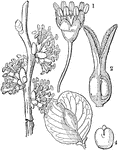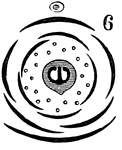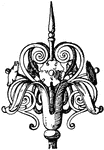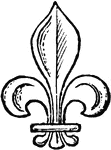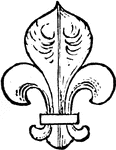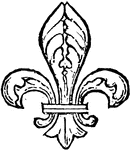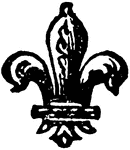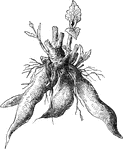
Polumnia Edulis
A tall yellow flower that is grown in the Andean region. The tubers of this plant are edible.
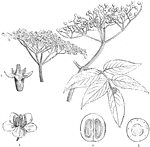
Elder
"Sambucus nigra; 1. a flower; 2. a young pistil; 3. a cross section of its ovary; 4. a perpendicular…
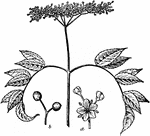
American Elderberry
"Branch with Inflorescence of Elder (Sambucus Canadensis). (a), part of the inflorescence; (b), fruits."…
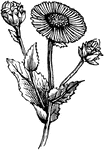
elecampane
The Elecampane (Inula helenium) is a flowering plant in the Asteraceae family of daisies.
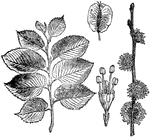
English Elm
Now known as Ulmus procera, the image shows a "Flowering Branch and Foliage of English Elm (Ulmus campestris),…
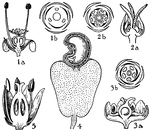
Orders of Empetraceae, Coriariaceae, Anacaridaceae, and Cyrillaceae
The orders pictured are empetraceae, coriariaceae, anacaridaceae, and cyrillaceae. The flowers of these…

Epps's Sulphurator
"Sulphurators are instruments for distributing flowers of sulphur, for the purpose of destroying mildew.…
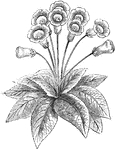
Erect Flowered Gloxinia
Though gloxinia flowers were originally drooping there are now many erect varieties.

Erect Flowered Gloxinia
Though gloxinia flowers were originally drooping there are now many erect varieties.
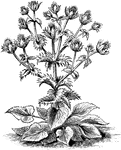
Eryngium Giganteum
The common name of eryngium is eryngo. Eryngium giganteum flowers are blue and oval shaped. Each stem…
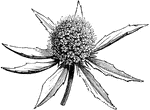
Eryngium Planum
The common name of eryngium planum is eryngo. Eryngium planum flowers are blue with round heads. There…

Flowers of Erythraea Diffusa
The common name of erythraea is centaury. Erythraea diffusa flowers are a bright, deep rose. The plant…
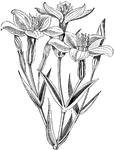
Flowering Stem of Erythraea Muhlenbergi
The common name of erythraea is centaury. Erthraea muhlenbergi has deep pink flowers with greenish-white…

Portion of Annual Herbaceous Flowering Shoot of Erythrina Crista-Galli
The common name of erythrina crista-galli is the common coral-tree. This tree has bright, deep scarlet…
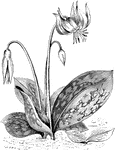
Large White Variety of Erythronium Dens-Canis
The common name of erythronium dens-canis is dog's tooth violet. The flowers are a purplish-rose or…

Orders of Erythroxylaceae, Zygophyllaceae, and Rutaceae
Pictured are the orders of erythroxylaceae, zygophyllaceae, and rutaceae. The flowers of these orders…
Escallonia
"Escallonia pulverulenta. 1. a flower; 2. a cross section of the ovary; 3. fruit; 4. seed; 5. its perpendicular…
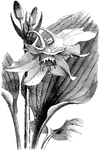
Leaves and Inflorescence of Eucharis Grandiflora
Eucharis grandiflora flowers are four to five inches wide and they droop at the end of the stems. The…
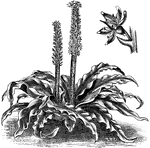
Eucomis Punctata
Eucomis punctata is native to South Africa. The flowers are green and brown. The leaves are oblong and…

Euphorbia Meloformis
The common name of euphorbia is milkwort or spurge. Euphorbia meloformis is melon shaped with greenish…

Eurycles Cunninghami
The common name of eurycles cunninghami is brisbane lily. The flowers are white. The plant grows to…
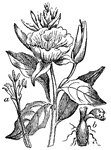
Evening Primrose
"Evening Primrose: a, flower divested of calyx and corolla, to show the parts or fructification; b,…
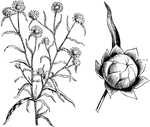
Habit and Detached Flower Head of Everlastings (Helichrysum Bracteatum Aureum)
Helichrysum bracteatum aureum are everlastings with golden yellow flower heads.

Flower Heads of Everlastings (Helichrysum Bracteatum Compositum)
Helichrysum bracteatum compositum is a fine, double strain of everlastings. The flower heads come in…
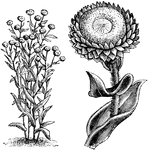
Habit and Detached Single Flower Head of Everlastings (Helichrysum Foetidum)
Helichrysum foetidum is a variety of everlastings with light yellow flower heads. The flowers bloom…

Eyebright
A genus of plants of natural order Scropulariaceæ. having a tubular calyx, the upper lip of the…
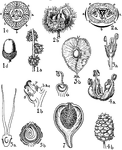
Fagaceae, Ulmaceae, and Moraceae Orders
Shown are the orders of Fagaceae, Ulmaceae, and Moraceae. Illustrated are various flowers and flower…
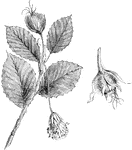
Branchlet of Fagus Sylvatica with Male and Female Flowers
The common name of fagus sylvatica is common beech. The male flowers have drooping heads. The female…

False Rue Anemone
The plant and fruit of the False Rue Anemone (Isopyrum biternatum). It is a flowering plant in the Ranunculaceae…

Fat-Hen
"7. a flower of Chenopodium album; 8. a section of the same, showing the superior ovary; 9. its seed…
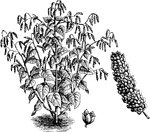
Prince's Feather
Also known as Polygonum orientale. A flower that is commonly found in southeastern Asia and Australia.…
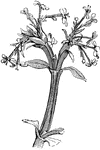
Flowering Branch of Fedia Cornucoplae
Fedia cornucoplae has red flowers that grow in clusters. The stem is a purplish color. The plant grows…
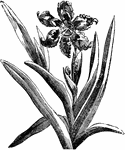
Flowering Spike of Ferraria Undulata
The flowers of ferraria undulata are greenish brown. The leaves overlap and taper to a slim point.

Ranunculus Ficaria
A plant with bright yellow flowers and short stems. They tend to bloom between March and May in Europe.
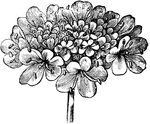
Inflorescence of Field Scabious
An illustration of the inflorescence of the field scabious. Knautia arvensis, commonly known as Field…

Ray-floret of Field Scabious
An illustration of a ray-floret of the field scabious. Knautia arvensis, commonly known as Field Scabious,…

Ray-floret of Field Scabious
An illustration of a ray-floret of the field scabious. Knautia arvensis, commonly known as Field Scabious,…

Seed of Field Scabious
An illustration of the seed of the field scabious. Knautia arvensis, commonly known as Field Scabious,…

Young Inflorescence of Field Scabious
An illustration of the young inflorescence of the field scabious. Knautia arvensis, commonly known as…

Maryland Figwort
"The inflorescence of Maryland Figwort (Scrophularia Marylandica). a, the flower; b, the fruit; c, a…

Fruiting Branchlet of Filbert
Filbert is a shrub that produces nuts, similar to the hazelnut. Filberts can be distinguished by the…

Leafless Twig of Filbert
In the early spring the pollen-bearing catkins appear before the female flowers. A shows the male catkins,…

Medieval Grill Finial
The medieval grill finial is made out of wrought-iron and is in the shape of a flower.

Part of Grill Finial
The part of grill finial is a 15th century design found on the Toulouse Cathedral in France. It is made…

Spanish Trellis Gate Finial
This is part of a spanish trellis gate. Designed during the 14th century, it is made of wrought-iron…

Terminal Finial
The terminal finial is a 17th century design found in Bruges, Belgium. It is made out of wrought-iron…
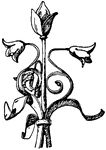
Termination of Fountain Finial
The termination of fountain finial is a 15th century design found in the Cluny museum in Paris, France.…
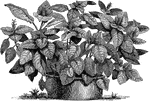
Fittonia Gigantea
The habit of fittonia gigantea is branching and erect. The flowers are pale red. The leaves are broad…

Common Flax
Common Flax (Linum usitatissimum) is a flowering plant in the Linaceae family of flaxes.
